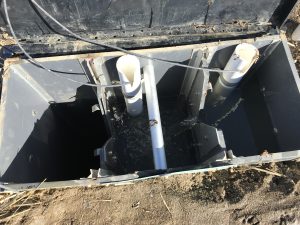September 7, 2022
Across Ohio, farmers are taking up the call to work together to improve water quality for our families and communities. One particular ongoing conservation program, the Blanchard River Demonstration Farms Network, continues to expand its focus on advancing research and showcasing real-world examples of the best land management practices by partnering with farmers in northwest Ohio.

The Demonstration Farms Network specifically addresses critical water quality issues through innovative conservation practices. A relatively new conservation practice being evaluated by the program is a saturated buffer.
A saturated buffer is an edge-of-field conservation practice that is intended to remove nitrate and other potential nutrients from subsurface field tile drainage in farm fields before it enters ditches, streams, and other surface waters. It’s a critical conservation practice that’s capable of reducing nutrient runoff with little annual maintenance by the farmer to ensure effective operation.
While this practice has been studied across the Midwest, there is limited research about how this practice performs in Ohio. As a result, the Demonstration Farms Network partnered with researchers Dr. Stephen Jacquemin, Professor of Biology at Wright State University Lake Campus, and Theresa Dirksen, Agriculture and Natural Resources Director in Mercer County, to address the benefits and costs of this practice within the topography and soil characteristics of northwest Ohio.
“Saturated buffers are an underutilized tool in northwest Ohio that could help us continue to make progress towards sustainable long-term nutrient reductions,” says Jacquemin. “They offer a unique combination of riparian management and controlled drainage to help reduce nutrient loads leaving fields.”
To demonstrate a saturated buffer’s ability to reduce nutrient loss, a dedicated research site, known as the St. Charles saturated buffer, was constructed within the agricultural landscape of the Grand Lake St. Marys watershed in Mercer County, Ohio.
Installed along an open ditch within a 30-acre subwatershed area, the saturated buffer has an approximately 40-foot vegetative buffer zone planted with cool-season grasses. Not only does this vegetative zone provide uptake of lost nutrients but it also serves as a habitat for wildlife. “Saturated buffers not only help to reduce nutrient runoff but the restoration of a riparian edge can be great for wildlife too – enhancing the biological diversity potential of an area,” says Jacquemin.
When there is subsurface tile drainage flow, a three-chambered water control structure regulates water flow to the buffer. The water control structure utilizes two sets of stop logs, wherein the initial stop log acts as a controlled drainage mechanism for the field. Once the water table is high enough to leave the field, the water flows into a central portion of the control structure where it is distributed along the length of the 1,200-foot distribution tile. Any water that does not percolate through the soil can leave the central chamber of the control structure to continue flowing out the third chamber and into the stream.

Comparing the drainage water outflow to a paired monitoring site without a vegetative buffer zone or water control structure, researchers monitored the volume of water reduced over a year at the St. Charles saturated buffer site.
During the initial monitoring period from December 13, 2020 to December 12, 2021, researchers noted that conditions were extremely dry over the first half of the year. However, the total annual precipitation during the study period was 33.1 inches and approximately 11 distinct rain events occurred to raise the water table in the field enough to initiate active tile runoff from the field into the buffer.
As a result, researchers found that the field exhibited a 70% reduction in outflow volume as an effect of the first stop log in the water control structure. Flow volume was further reduced through the buffer’s vegetation by processing approximately 35% of flow leaving the field. Once infiltrated, abiotic and biotic processes facilitated significant nutrient reductions of dissolved nitrogen and phosphorus.
This project is scheduled to complete water quality monitoring in 2022 to generate a full two years of data from which to draw conclusions.
Saturated buffers exhibit a strong potential to find their way into farmers’ conservation tool bags as they work together with researchers to reduce nutrient runoff across the region.
To learn more about the conservation practices improving agriculture’s impact on downstream water quality in Ohio, please visit the Conservation Practice page.
Related Posts
Ready to learn more?


